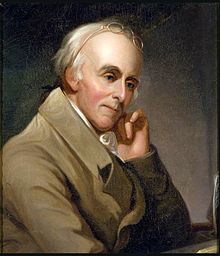Shipping from Europe with tracking number / 40mm,bronze
Benjamin Rush
Benjamin Rush | |
|---|---|
 Portrait by Charles Willson Peale, c. 1818 | |
| Born | January 4, 1746 |
| Died | April 19, 1813 (aged 67) Philadelphia, Pennsylvania, U.S. |
| Resting place | Christ Church Burial Ground, Philadelphia |
| Alma mater | Princeton University University of Edinburgh |
| Occupation | Physician, writer, educator, medical doctor |
| Known for | Signer of the United States Declaration of Independence |
| Children | 13, including Richard and James |
| Signature | |
Benjamin Rush (January 4, 1746 [O.S. December 24, 1745] – April 19, 1813) was a Founding Father of the United States who signed the United States Declaration of Independence, and a civic leader in Philadelphia, where he was a physician, politician, social reformer, humanitarian, educator, and the founder of Dickinson College. Rush was a Pennsylvania delegate to the Continental Congress.[1] His later self-description there was: "He aimed right."[2][3] He served as surgeon general of the Continental Army and became a professor of chemistry, medical theory, and clinical practice at the University of Pennsylvania.[4]
Rush was a leader of the American Enlightenment and an enthusiastic supporter of the American Revolution. He was a leader in Pennsylvania's ratification of the U.S. Constitution in 1788. He was prominent in many reforms, especially in the areas of medicine and education. He opposed slavery, advocated free public schools, and sought improved, but patriarchal,[5] education for women, and a more enlightened penal system. As a leading physician, Rush had a major impact on the emerging medical profession. As an Enlightenment intellectual, he was committed to organizing all medical knowledge around explanatory theories, rather than rely on empirical methods. Rush argued that illness was the result of imbalances in the body's physical system and was caused by malfunctions in the brain. His approach prepared the way for later medical research, but Rush undertook none of it. He promoted public health by advocating clean environment and stressing the importance of personal and military hygiene. His study of mental disorder made him one of the founders of American psychiatry.[6] In 1965, the American Psychiatric Association recognized Rush as the "father of American psychiatry".
Abram Belskie
Abram Belskie | |
|---|---|
 Abram Belskie | |
| Born | March 24, 1907 |
| Died | November 7, 1988 (aged 81) |
| Occupation | Sculptor |
Abram Belskie (March 24, 1907 – November 7, 1988) was a British-born sculptor. He is known for his 1939 collaboration with Dr. Robertson Dickinson on the Birth Series Sculptures.[1]
Biography[edit]
Belskie was born in London and grew up in Glasgow, Scotland. He graduated from the Glasgow School of Art in 1926. In 1929 he emigrated to New York, USA, to work for British sculptor John Gregory.[2]
In 1938 Belskie was introduced to physician Robert Latou Dickinson and subsequently applied his skills to create medical models, some of which were exhibited at the World's Fair of 1939. This was known as the Dickinson-Belskie Birth Series.[3] In 1942, he created two sculptures, Norma and Normman, based on data collected by Dickinson, intended to represent the statistical ideal female and male figure.[4] After Dickinson's death in 1950, Belskie instead created medallions (occasionally medicine-related).[2]
Belskie died in 1988 and, in 1993, the Belskie Museum of Arts and Science was opened in Closter, New Jersey. It was founded by the Closter Lions Club to preserve, house and exhibit the works of Abram Belskie. It was entirely funded by membership fees, donations, grants and local subsidies.[5]
Memberships
- National Sculpture Society, fellow
- National Academy of Design, fellow
- The American Numismatic Society, fellow
- Allied Artists of America.
Awards
- John Keppie Traveling Scholarship, Scotland, 1926;
- Sir John Edward Burnett Prize, Scotland, 1928;
- Lindsay Morris Memorial Award, 1951;
- J. Sanford Saltus Medal, American Numismatic Society, 1959:
- Mrs. Louis Bennett Award, 1956; Golden Anniversary Prize, Allied Artists of America, 1963
Collections
In addition to private collections, Belskie's work is exhibited at:
- American Museum of Natural History, New York [5]
- The Field Museum, Chicago, Illinois[5]
- Mariner's Museum, Newport News, Virginia
- Brookgreen Gardens, Pawley Island, South Carolina
- Cleveland Health Museum, Cleveland, OH;
- Johnson & Johnson, New Brunswick, New Jersey.
- Jewish Theological Seminary, New York
- Park Avenue Synagogue, New York
- New York Academy of Medicine, New York [5]
- The Belskie Museum, Closter, New Jersey